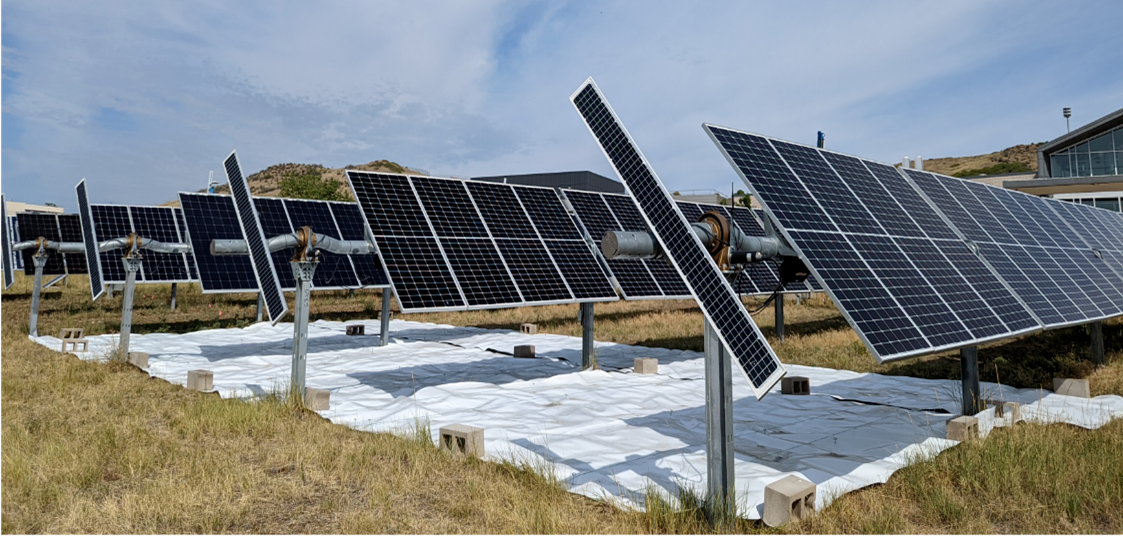Reviewed by Lexie CornerMay 8 2024
University of Ottawa researchers have developed a way to boost solar panel efficiency by adding reflective surfaces under the panels. This simple technique can increase energy output by 4.5 %, making solar power more economically viable in diverse locations. The study was published in the journal Progress in Photovoltaics.
 Artificial reflector experiment performed on the Bifacial Experimental Single-Axis-Tracking Site (BEST Site) at NREL in Golden, Colorado. Image Credit: University of Ottawa
Artificial reflector experiment performed on the Bifacial Experimental Single-Axis-Tracking Site (BEST Site) at NREL in Golden, Colorado. Image Credit: University of Ottawa
Solar energy is a pivotal asset in combatting climate change. Thus, in this study, researchers have created an innovative approach that involves integrating artificial ground reflectors, a straightforward yet potent enhancement, into solar panels.
The researchers discovered that adding these reflectors to solar setups could increase the energy output and efficiency of the system, improving the viability of such projects from an economic standpoint. This finding is important when it comes to weighing up the advantages and disadvantages of employing artificial reflectors in solar energy projects.
In Golden, Colorado, the National Renewable Energy Laboratory (NREL), a renowned global hub for clean energy research, development, and deployment, has teamed up with the University of Ottawa's SUNLAB. Under the leadership of Electrical Engineering Professor Karin Hinzer, who also serves as Vice-Dean of Research in the Faculty of Engineering, they are investigating the influence of reflective ground covers on solar energy output.
Mandy Lewis, a Doctoral Candidate in Electrical Engineering from Golden, Colorado, conducted the study. Results showed that covering solar panels with reflective surfaces can boost the panels' energy output by as much as 4.5 %.
We found that highly reflective white surfaces can boost solar power output. Critically, these reflectors should be placed directly under the solar panels, not between rows, to maximize this benefit.
Mandy Lewis, Study Lead Author and Doctoral Candidate, Department of Electrical Engineering, University of Ottawa
Unlocking Solar Potential in Canada and Beyond
These results are especially noteworthy for Canada, where major cities like Ottawa and Toronto experience snow cover for three to four months of the year, and 65 % of the country's vast landmass experiences snow cover for more than half the year. In these areas, bifacial solar systems present enormous potential when combined with high-ground reflectivity. This discovery has worldwide implications because sandy deserts comprise about 4 % of all land areas on Earth.
This research is crucial for maximizing solar energy production in geographically diverse locations. Furthermore, by generating more power per unit of land area, reflectors are ideal for densely populated areas, like city centers, where space limitations exist for solar installations.
Mandy Lewis, Study Lead Author and Doctoral Candidate, Department of Electrical Engineering, University of Ottawa
This study signals the initiation of a new international research partnership between the University of Ottawa and NREL. Funding for the project came from the US Department of Energy (DoE), Ontario Graduate Scholarships (OGS), and the National Sciences and Engineering Research Council of Canada (NSERC). This highlights the value of teamwork in developing renewable energy technologies.
Global Impact in Facilitating the Transition to Clean Energy
This study will make a major contribution to the global switch to energy sources with no emissions. With power gains of 6.0 % in cloudy Seattle and 2.6 % in arid Tucson, these results are especially relevant to Canada and other cloud-domesticated nations.
Journal Reference:
Lewis, R. M., et al. (2024) Artificial ground reflector size and position effects on energy yield and economics of single-axis-tracked bifacial photovoltaics. Progress in Photovoltaics. doi.org/10.1002/pip.3811.